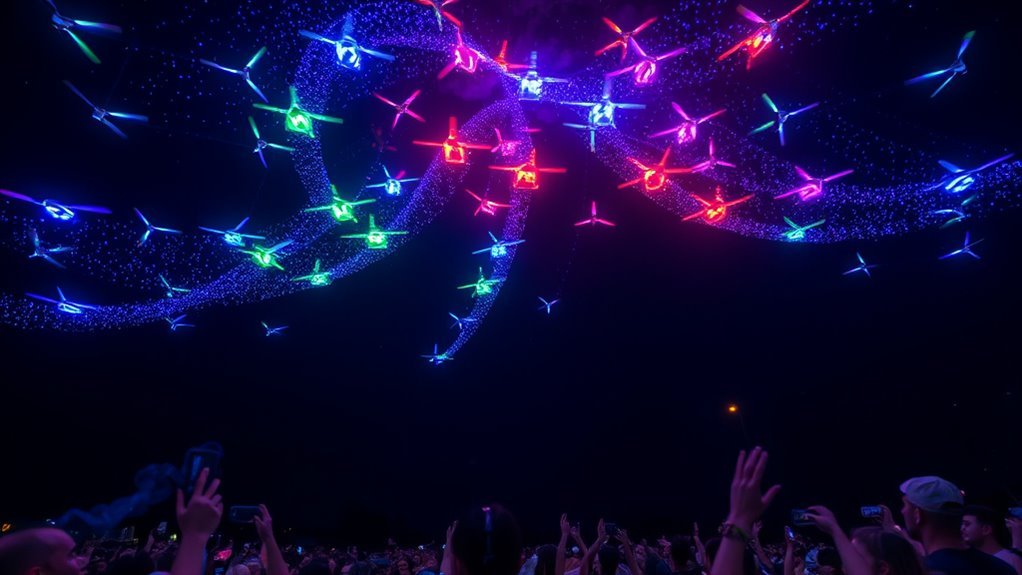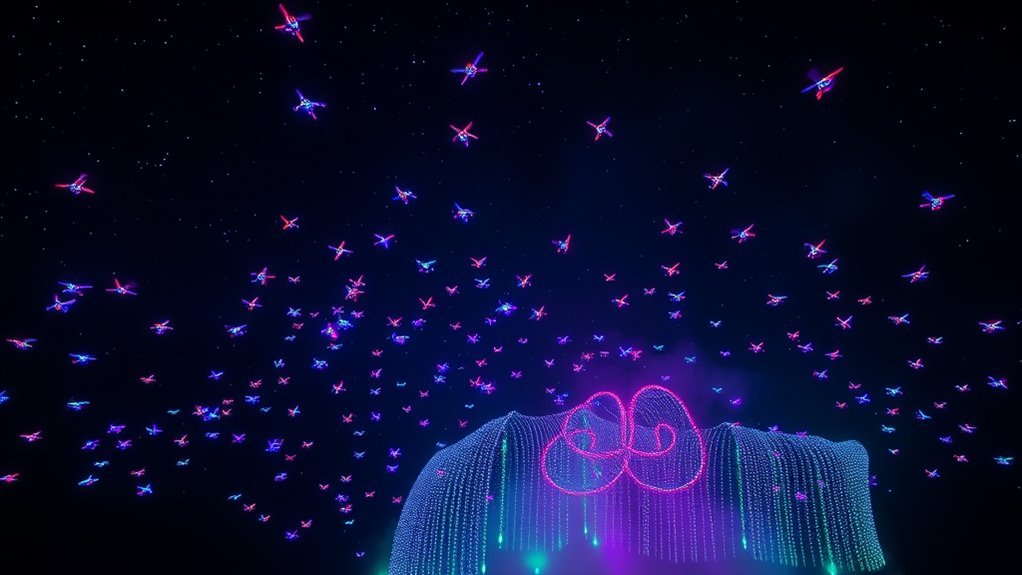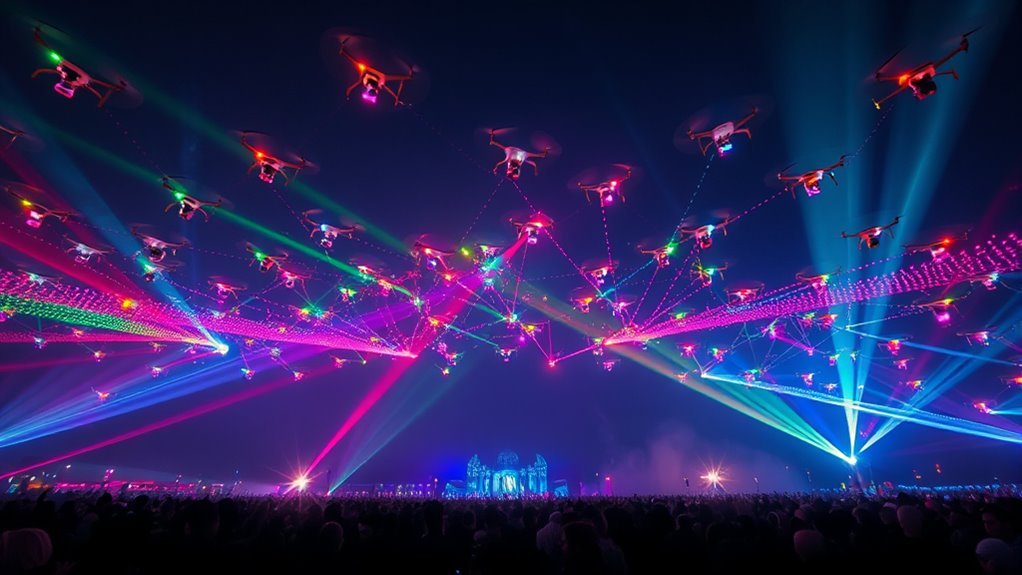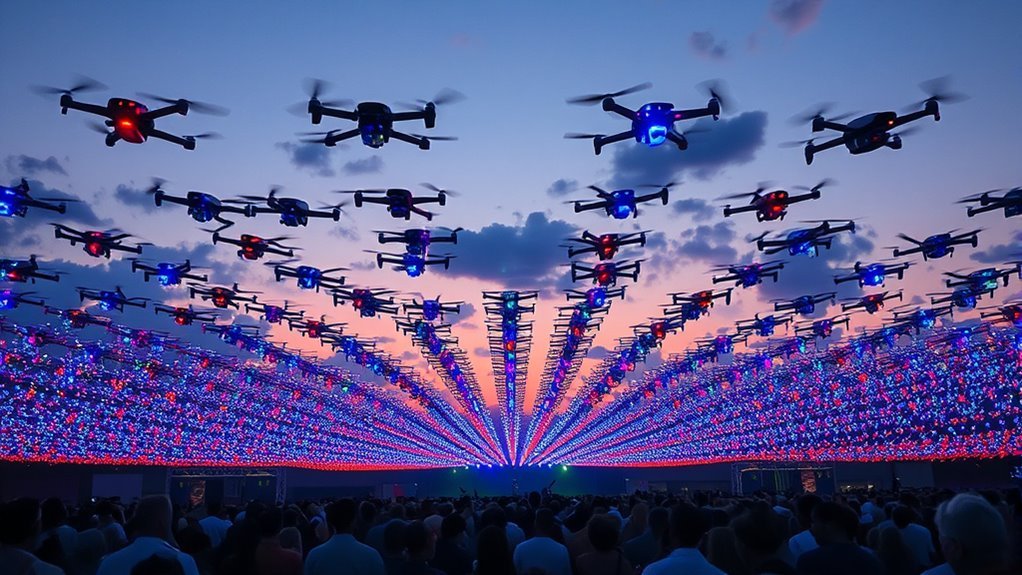A drone light show works by synchronizing a fleet of programmed drones, each equipped with high-intensity LED lights, to create intricate aerial displays. These drones are programmed with precise choreography that involves real-time communication and GPS navigation for accurate positioning. Timing control and altitude variation enhance the visual effects. By integrating technology and artistry, these coordinated performances transform the night sky. Keep exploring to uncover the technology and creativity that drive these stunning displays.
The Basics of Drone Light Shows

Drone light shows represent a sophisticated blend of technology and artistry, as they utilize fleets of programmed drones equipped with LED lights to create stunning visual displays in the night sky. Each drone operates in precise formations, enabling intricate choreography that transforms the aerial space into a canvas for artistic expression. Aerial artistry comes alive as these formations shift and evolve, synchronizing with music or thematic narratives. The programming behind these shows involves meticulous planning, where every movement and color change is calculated to evoke emotion and wonder. Real-time communication systems are essential for ensuring that all drones remain coordinated throughout the performance. Notably, companies like SkyMagic Drone Light Shows have pioneered advancements in drone technology that enhance the overall experience. You’ll appreciate how drone light shows not only showcase technological innovation but also liberate creative possibilities, allowing artists to explore new dimensions of visual storytelling in the open sky, free from conventional constraints.
The Technology Behind the Drones

At the heart of a drone light show lies advanced technology that enables seamless coordination and intricate visual displays. You’ll find that drone navigation systems utilize GPS and inertial measurement units to guarantee precise positioning in the sky. Coupled with LED technology, these drones can create stunning color patterns and dynamic visuals that captivate audiences.
| Feature | Description | Importance |
|---|---|---|
| Drone Navigation | GPS and IMU for accurate positioning | Essential for synchronization |
| LED Technology | High-intensity, programmable LEDs | Creates vibrant visual effects |
| Battery Life | Advanced lithium polymer batteries | Guarantees longer flight duration |
| Communication | Real-time data exchange between drones | Enables coordinated movements |
With this technology, each drone operates autonomously yet harmoniously, enhancing the overall spectacle.
Choreography and Synchronization

The intricate visual displays created by drones rely heavily on meticulous choreography and synchronization. To achieve stunning shows, several choreography techniques are employed, addressing synchronization challenges that arise during performances. You can visualize this process through the following elements:
- Formation Design: Strategically planning how drones move to create dynamic shapes. The use of autonomous software systems allows for greater precision in drone movements, enhancing the overall performance quality.
- Timing Control: Ensuring each drone’s movements are perfectly timed to maintain harmony.
- Altitude Variation: Adjusting heights for visual depth and layering effects.
- Color Coordination: Synchronizing light changes to enhance the artistic expression of the display.
Each element is essential for creating a cohesive and immersive experience, allowing the audience to witness the freedom of movement and artistry that drone light shows can deliver. Additionally, the use of software simulations helps refine the choreography, ensuring each drone performs its movements with precision and accuracy.
Programming the Light Show
While crafting a mesmerizing light show, programming plays an essential role in orchestrating the drones’ movements and light displays. To achieve stunning visuals, you’ll rely on various programming languages, such as Python or C++, enabling precise control over each drone’s trajectory. Sequence algorithms are critical for determining the order and timing of movements, ensuring that all drones act in unison. By inputting specific parameters, you can establish patterns and dynamic changes, creating a cohesive experience. Additionally, testing and iteration are fundamental in refining the show, allowing you to troubleshoot potential issues before the live performance. Ultimately, mastering programming techniques empowers you to release your creativity and produce a enchanting aerial spectacle that resonates with freedom and innovation.
Safety Measures and Regulations
Creating an impressive drone light show involves not just programming but also adhering to safety measures and regulations to guarantee a secure environment for both participants and spectators. You need to confirm compliance with drone regulations and implement robust safety protocols. Here are key considerations:
- Airspace Authorization: Verify that you’re cleared to operate in the designated airspace.
- Pilot Certification: Ensure that your drone pilots are certified and knowledgeable about regulations.
- Crowd Control: Establish safe viewing areas to keep spectators at a safe distance.
- Emergency Procedures: Create protocols for potential malfunctions or emergencies, including rapid landing plans. Additionally, understanding federal guidelines on drone operations is crucial to avoid legal complications during the show.
The Role of Software in Drone Displays
Although many might underestimate its importance, software plays an essential role in orchestrating a drone light show. The intricate choreography of drones relies heavily on sophisticated software algorithms that determine flight paths, timing, and synchronization. These algorithms guarantee that each drone moves precisely to create stunning visual effects, enhancing the overall experience. By controlling factors such as altitude, speed, and orientation, the software enables seamless coordination among numerous drones, transforming them into a cohesive display. Advanced programming also allows for real-time adjustments, assuring safety and responsiveness to environmental changes. Ultimately, the effectiveness of a drone light show hinges on the software’s ability to translate artistic vision into an aerial spectacle, providing a sense of freedom through technology and creativity. Additionally, the integration of AI algorithms allows drones to adapt in real-time, enhancing safety and efficiency without human intervention. This is achieved through real-time coordination techniques that ensure precise timing and prevent collisions among the drones.
Case Studies of Iconic Drone Shows
In examining case studies of iconic drone shows, you’ll notice key highlights from notable events that captivate audiences worldwide. You’ll also see innovative design techniques that enhance visual storytelling and the technical advancements that make these displays possible. Analyzing these elements will provide insights into the evolving landscape of drone entertainment. One such example is the Disney Springs show, which features approximately 50 drones that create intricate aerial performances through synchronized light displays. The Disney Springs drone show exemplifies how festive music can enhance the overall experience by syncing with the aerial display.
Notable Event Highlights
Drone light shows have transformed the landscape of entertainment and public events, showcasing innovative technology and artistic expression. These memorable moments are often defined by event highlights that leave audiences in awe. Here are four notable examples:
- 2020 Tokyo Olympics: A stunning display of 1,824 drones formed the iconic Olympic rings, symbolizing unity and celebration.
- New Year’s Eve in Sydney: A synchronized performance featuring over 100 drones illuminated the harbor, creating a dazzling backdrop for fireworks.
- Super Bowl LV: Drones depicted a giant, glowing football during halftime, enhancing the excitement of the game.
- 2021 Coachella: A vibrant display of colors and patterns captivated festival-goers, blending technology and art seamlessly.
These events underscore the potential of drone shows to redefine entertainment experiences.
Creative Design Techniques
As technology evolves, the creative design techniques behind iconic drone shows have become increasingly sophisticated, allowing for intricate visual narratives. Designers draw from diverse design inspiration, merging art and technology to craft compelling visual storytelling. For instance, the 2021 Olympics featured a breathtaking display that seamlessly integrated cultural motifs, demonstrating how thematic elements can create a profound emotional connection with audiences. Each drone’s choreography is meticulously planned, ensuring synchronization and precision that amplify the story being told. Utilizing advanced software, designers can visualize each sequence before execution, enabling them to refine aesthetics and timing. This analytical approach not only enhances the overall experience but also empowers creators to push the boundaries of drone artistry, ultimately enriching the viewers’ freedom to engage with the narrative.
Technological Innovations Employed
The intersection of creativity and technology in drone shows is illuminated by various innovations that enhance performance and visual impact. You’ll find that the following advancements have been pivotal:
- LED advancements: Modern drones utilize high-efficiency LEDs, providing vibrant colors and sharp imagery that captivate audiences.
- Battery efficiency: Enhanced battery technology allows for longer flight times, enabling more intricate displays without interruptions.
- Real-time data processing: Advanced algorithms enable drones to synchronize movements flawlessly, creating seamless visual narratives.
- Autonomous flight systems: Cutting-edge navigation technology allows drones to operate independently, reducing the need for manual control and increasing safety.
These innovations not only elevate the artistic expression of drone shows but also reflect the evolving landscape of aerial entertainment.
The Future of Drone Light Entertainment
While advancements in technology continue to reshape entertainment, drone light shows stand at the forefront of this evolution, merging artistry with innovation. The future of drone light entertainment holds immense potential for audience engagement and reduced environmental impact. As regulations evolve, you’ll witness more creative displays and integrations with live events. Additionally, the integration of AI-driven obstacle avoidance can enhance the safety and reliability of drone performances, ensuring seamless execution during complex aerial displays. With synchronized drone performances, these shows can captivate viewers by transforming the night sky into a canvas of breathtaking visuals.
| Aspect | Current Trends | Future Prospects |
|---|---|---|
| Audience Engagement | Interactive features | Personalized experiences |
| Environmental Impact | Minimal emissions | Sustainable practices |
| Technological Growth | Enhanced coordination | AI-driven choreography |
Frequently Asked Questions
How Much Does It Cost to Organize a Drone Light Show?
Imagine planning a wedding; the budget breakdown’s essential. For a drone light show, pricing factors include the number of drones, duration, and location. Expect costs ranging from $10,000 to $100,000, depending on your vision.
Can Drone Light Shows Be Held Indoors?
Yes, drone light shows can be held indoors, but you’ll need to take into account indoor drone safety and venue considerations carefully. Adequate space, ventilation, and safety protocols are essential to guarantee a successful performance.
What Are the Environmental Impacts of Drone Light Shows?
You might notice drones twinkling like stars, yet their environmental impacts include reduced noise pollution compared to fireworks. While they offer visual brilliance, it’s essential to weigh these environmental benefits against potential ecological disruptions during shows.
How Long Does a Typical Drone Light Show Last?
A typical drone light show lasts between 10 to 30 minutes, depending on the complexity of the drone choreography and desired show duration. Each performance’s timing is meticulously planned to maximize visual impact and audience engagement.
What Is the Maximum Number of Drones Used in a Show?
You might think there’s a limit, but in reality, show coordination and drone technology allow for thousands of drones—up to 1,000 or more—creating stunning visuals, proving your imagination’s the only real constraint.

